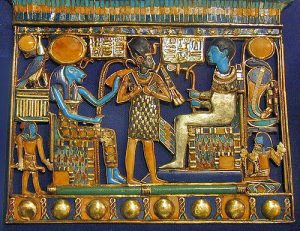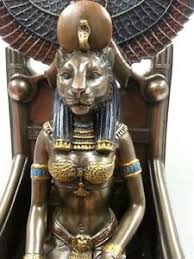The Triad of Memphis

Built by the kings of the First Dynasty, Memphis had been the capital city of Egypt around 3000 BC, after the unification of Upper and Lower Egypt. Though not much have survived from ancient Memphis, little remains– including scattered statues, alabaster beds, gigantic sarcophagi, sphinxes, and temples– provide clues to the religious life of the city. At the reduction of influence of gods of Heliopolis, about the fifth and sixth dynasties, the gods of Memphis started to take a new character. As first principle, creator, 'father of gods', and head of a triad (that included his consort Sekhmet and their son Nefertem ), god Ptah (who was believed to have had international political powers) was combined with the gods of Heliopolis. Since Horus was an ingredient of god Ptah, the latter was made a supreme god when the former became the god of both Upper and Lower Egypt (after wars between him and Seth were brought to an end).
- The Hidden God Ptah

Ptah was the head of the Triad of Memphis accompanied by his wife Sekhmet and his son Nefertem. The origin of Ptah is still controversial: some scholars believe that he is the incarnation of the Apis Bulls; others state that he is "a variation of the sun god"; and some others suggest that he is related to the moon. In one of the prayers to Ptah, there is an indication that his right eye is the sun and his left is the moon; and by both of which day and night are circled. Some inscriptions on a granite slab dating to the Twenty-fifth Dynasty identify Ptah with Ta-Tenen (an ancient earth-god from Memphis) and with the king. Ptah is presented in many texts as the creator of himself and the father of all the other immortal gods. He is belived to be the provider of food and provisions and all the other blessings that help the mortal beings in leading a happy life. Many ancient myths amalgamate Ptah with other gods such as Osiris and Sokaris. In the Book of the Dead, Ptah is assigned with opening the mouth of the recently dead person with his metal knife to give him the breath of eternity and this justifies calling him the" Lord of Resurrection".
Ptah was known with several names due to the various role attributed to him including the Fashioner of Earth, the King of Two Lands, and the God of Beautiful Face since he was regarded as the creator of his own self and the creator and dominant of the whole earth. Ptah is usually depicted as a bearded bald-headed man wearing a tight garment; holding a scepter of three symbols (strength, life and stability); and standing on the platform associated with Maat with a flower symbolizing happiness gracefully hung at his neck's back. The main cult for Ptah was the Temple of Ptah that marks the increase of his power among the other gods and goddesses. In addition to that there are many other places involving statues for Ptah or paintings depicting worshiping him all over Egypt. The Temple of Seti I in Abydos is one of the major places that encloses some wall paintings for the king while praying for the Chief god. In addition to that, numerous statues for Ptah and his wife Sekhmet have been found in the Temple of King Thutmes III in Karnak complex. Many other statues for Ptah and the other members of the triad are displayed in the Egyptian Museum and the Temple of Ramsses II in Abu Simbel.
- Goddess Sekhmet

Goddess Sekhmet is Ptah's wife and sister. Her name means "to be strong, mighty, and violent". Usually she is depicted as a lion-headed woman dressed in red with a solar disk and a uraeus or cobra over her head and carrying the ankh (the sign of life). The reason for her great role in the ancient Egyptian mythology is the belief that she was the beloved daughter of Ra whose destructive power was used for attacking his enemies and punishing those who disobey him. Among the name she was known for in the ancient mythology: "Great Lady", "the Holy Powerful One" and many other names. Often given the name 'the Eye of Ra', Sekhmet is thought to be the daughter of Ra that supposedly represented the traditional evil eye, the eye represents the god at attacking his foes. She possessed both might and violence and there are many references attesting her destructive use of the heat of the sun. Being a goddess of war and accompanying the king into battlefields, she was associated with weapons like arrows and swift darts. She was associated with the hot blows of winds. In the Book of the Dead, it is mentioned that, at times, her power exceeds that of the god of the underworld, especially when storms blow or floods come. Nevertheless, what virtually seems contrary to her wild nature is her possessing magical insights.
- The God Nefertem
 In the ancient Egyptian mythology, Nefertem is the son of Ptah and Sekhmet. Some texts found in the Pyramid of Unas at Saqqara and some vignettes of the Book of the Dead negotiates that Nefertem had risen from the lotus to the nostrils of Ra and went forth from the horizon. In his usual depiction, he appears as a man wearing lotus blossoms permanently on his head and carrying an ankh. On some reliefs, he is pictured putting his feet on a lion or a lion-headed body. Despite being the son of Ptah and Sekhmet, his actions were quite contradictory with his mother's: he was the god of fragrance who allowed only pleasant odors to ascend to the solar god during his daily passage through the sky. In addition to that some of the hymns highlight that he played an important role in the afterworld in purifying the dead people from their 42 sins.
In the ancient Egyptian mythology, Nefertem is the son of Ptah and Sekhmet. Some texts found in the Pyramid of Unas at Saqqara and some vignettes of the Book of the Dead negotiates that Nefertem had risen from the lotus to the nostrils of Ra and went forth from the horizon. In his usual depiction, he appears as a man wearing lotus blossoms permanently on his head and carrying an ankh. On some reliefs, he is pictured putting his feet on a lion or a lion-headed body. Despite being the son of Ptah and Sekhmet, his actions were quite contradictory with his mother's: he was the god of fragrance who allowed only pleasant odors to ascend to the solar god during his daily passage through the sky. In addition to that some of the hymns highlight that he played an important role in the afterworld in purifying the dead people from their 42 sins.
- Imhotep


It is debatable whether or not Imhotep, the son of ptah and Sekhmet whose name meant "he who comes in peace," is the third member of the triad of Memphis. He is depicted as a bald-headed man in a scribe-like posture with papyrus on his knees. Among his names are the "Great One, Son of Ptah, the Creative God, made by Thenen, Begotten by Him and Beloved by Him, the God of Divine Forms in the Temples, who Gives Life to All Men, the Mighty One of Wonders, the Maker of Times and many other names deifying his great power and blessings. Recognized as a god of medicine who sent sleep to those in severe pain and suffering, Imhotep was famous for his healing abilities and curative powers, the reason why he was often associated with Thuth, the god of wisdom. The worshipers of Imhotep were usually sacrificing Ibisis in his tomd and sick people pled for being healed by Imhotep's miraculous cures.
One of the most interesting myths of Imhotep highlights his role as the god who helps women to give birth in boys. The tale relates that a miserable married couple had no male heirs went to a temple of Imhotep and pled for giving birth to a boy. Falling asleep in the temple, she had a dream that instructed her to make a medicine for her husband from the root of a certain plant, the colocasia. As she did, she became pregnant with a baby boy. Besides being Zoser's chief advisor early in the Third Dynasty (2686 B.C), Imhotep was the architect of both the funerary complex and the King's Step Pyramid at Saqqara. In a famous myth, his duty as an advisor is highly manifested. That myth relates that Zoser went to Aswan to plead the god for stopping a famine that struck Egypt. After consulting his books, Imhotep said that the reason of god Khnum's rage was Zoser's negligence of the Temple of the god. Thus, he prescribed that a journey should be made to the angered god to whom the king should pay the due tribute. Though not a king and merely a man of a lower position, Imhotep was largely defied, especially after nearly two thousand years after his death. In Imhotep's honor, temples were erected at Memphis, Philae, and Thebes and a school of medicine and magic was built for him at a hospital at Memphis. Probably, his tomb (not yet discovered) lies somewhere in the funeral complex at Saqqara.




